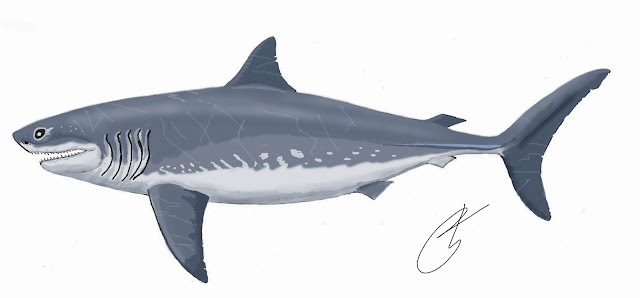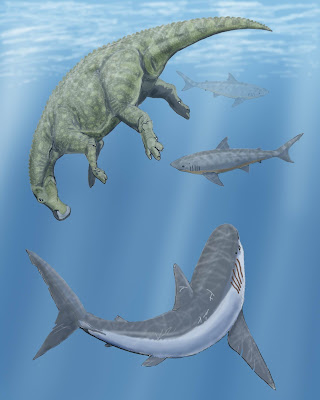![]() |
| ©Tuomas Koivurinne |
Cretoxyrhina was not always a bloodthirsty hunter. As happens in nature there were probably times like this one in which great hunters such as Tylosaurus and Cretoxyrhina crossed paths without attacking one another or the schools of fish that are lazily swimming around them. It was probably not often, but it more than likely happened at least once in the history of the Western Interior Seaway. One of the more exceptional characteristics of this piece is actually the symbiotic nature of the small fish attaching themselves to both the upper Tylosaurus and the Cretoxyrhina. In modern times remoras would be the fish holding on to that niche in the ocean ecology, however, we do not necessarily know that there was a fish living symbiotically with these sharks or that they would have been remoras if there were sharks living alongside smaller symbiotes at that time. Sometime in the future, perhaps, a great find will come along that proves or disproves this, but it is a very interesting modern relationship shown in an ancient system.
![]() |
| ©Dmitry Bogdanov |
The overall shape of Cretoxyrhina, along with many other extinct cartilaginous fishes, is subject to interpretation due to the lack of well ossified, and therefore fossilized, bits and pieces of cartilaginous fishes. Teeth and sometimes jawbones themselves do fossilize, but these are the better examples of what bits and pieces we do unearth that are related to Mesozoic sharks. Teeth and jaws allow for size extrapolations based on modern sharks' ratios between tooth/jaw size and body size, but the overall shape, as with so many other prehistoric animals and previously stated, is open to the interpretation of the illustrator. In that vein, searching for images of Cretoxyrhina pulls up bulldog nosed images such as this based off of
bull sharks, longer nosed animals based off of
mako shark body types, and of course, there are images, look at yesterday's image, based off of the great white shark body type.
![]() |
| ©Dmitry Bogdanov |
Dmitry Bogdanov did a great job of showing two of those body types previously discussed in his art featuring Cretoxyrhina. The first version, the bull shark-esque and short nosed version previously noted, is well done considering that body type. The body type in this image is much more related to the great white body plan while the background Squalicorax are closer to the bull shark body plan. Regardless, the Squalicorax and Cretoxyrhina alike are highly interested in the bloated, floating dinosaur carcass; as any good scavenger or opportunistic feeder would be when a free meal simply floats out to sea somehow. It appears, in this image, that a pecking order is about to be established amongst the scavengers, or that the feeding frenzy is just about to start between these three sharks and potentially more lurking in the shadows or moving in from off in the distance.















